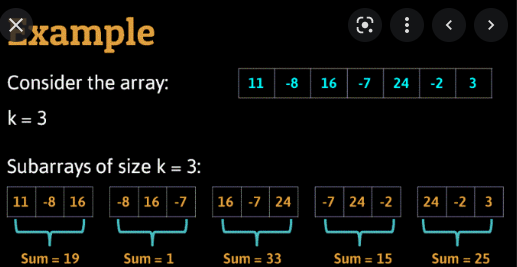Table of Contents
Problem Statement
Max Sum of Two Non-Overlapping Subarrays LeetCode Solution – When given an integer array nums and two integers firstLen and secondLen, we return the maximum sum of elements in two non-overlapping subarrays with lengths firstLen and secondLen.
Also, the array with length firstLen could occur before or after the array with length secondLen, but they have to be non-overlapping.
A subarray is a contiguous part of an array.
This image shows this:

Credit: https://www.ideserve.co.in/learn/img/MaximumAverageSubarraySizeK.gif
Example 1:
Input:
nums = [0,6,5,2,2,5,1,9,4], firstLen = 1, secondLen = 2
Output:
20
Explanation:
One choice of subarrays is [9] with length 1, and [6,5] with length 2.
Example 2:
Input:
nums = [3,8,1,3,2,1,8,9,0], firstLen = 3, secondLen = 2
Output:
29
Explanation:
One choice of subarrays is [3,8,1] with length 3, and [8,9] with length 2.
Example 3:
Input:
nums = [2,1,5,6,0,9,5,0,3,8], firstLen = 4, secondLen = 3
Output:
31
Explanation:
One choice of subarrays is [5,6,0,9] with length 4, and [0,3,8] with length 3.
Approach
Idea:
The main idea is that we want to both make the subarrays non-overlapping and secondly we want to make it so that we are adding the 2 subarrays with the largest totals so that our output is the largest that it can be. To go at this, firstly, we’ll calculate the prefix array sum. Now we tackle the other part of this problem which is making sure the subarrays are non-overlapping. Then, we’ll calculate the LMax value by considering L at leftmost, M at rightmost, and in the next pass, vice versa. And to reiterate, by keeping L and M at the ends of the array, we make the subarrays non-overlapping.
Code
Java Program of Maximum Sum of Two Non-Overlapping Subarrays:
class Solution {
public int maxSumTwoNoOverlap(int[] A, int L, int M) {
int sums[] = new int[A.length+1];
int maxLval = 0;
int maxRval = 0;
int result = 0;
for(int i=1;i<=A.length;i++)
sums[i] = A[i-1]+sums[i-1];
for(int i=L;i<=A.length-M;i++)
{
int currLVal = sums[i]-sums[i-L];
int currMVal = sums[i+M]-sums[i];
maxLval = Math.max(maxLval,currLVal);
result = Math.max(result,currMVal+maxLval);
}
for(int i=M;i<=A.length-L;i++)
{
int currMVal = sums[i]-sums[i-M];
int currLVal = sums[i+L]-sums[i];
maxRval = Math.max(maxRval,currMVal);
result = Math.max(result,currLVal+maxRval);
}
return result;
}
}C++ Program of Maximum Sum of Two Non-Overlapping Subarrays:
class Solution
{
public:
int maxSumTwoNoOverlap(std::vector<int> &A, int L, int M)
{
std::vector<int> sums(A.size() + 1);
int maxLval = 0;
int maxRval = 0;
int result = 0;
for (int i = 1; i <= A.size(); i++)
{
sums[i] = A[i - 1] + sums[i - 1];
}
for (int i = L; i <= A.size() - M; i++)
{
int currLVal = sums[i] - sums[i - L];
int currMVal = sums[i + M] - sums[i];
maxLval = max(maxLval,currLVal);
result = max(result,currMVal + maxLval);
}
for (int i = M; i <= A.size() - L; i++)
{
int currMVal = sums[i] - sums[i - M];
int currLVal = sums[i + L] - sums[i];
maxRval = max(maxRval,currMVal);
result = max(result,currLVal + maxRval);
}
return result;
}
};Python Program of Maximum Sum of Two Non-Overlapping Subarrays:
import math
class Solution :
def maxSumTwoNoOverlap(self, A, L, M) :
sums = [0] * (len(A) + 1)
maxLval = 0
maxRval = 0
result = 0
i = 1
while (i <= len(A)) :
sums[i] = A[i - 1] + sums[i - 1]
i += 1
i = L
while (i <= len(A) - M) :
currLVal = sums[i] - sums[i - L]
currMVal = sums[i + M] - sums[i]
maxLval = max(maxLval,currLVal)
result = max(result,currMVal + maxLval)
i += 1
i = M
while (i <= len(A) - L) :
currMVal = sums[i] - sums[i - M]
currLVal = sums[i + L] - sums[i]
maxRval = max(maxRval,currMVal)
result = max(result,currLVal + maxRval)
i += 1
return resultComplexity Analysis for Max Sum of Two Non-Overlapping Subarrays LeetCode Solution
Time Complexity
Firstly, the time complexity of the above code is O(n) because we are traversing the array only once.
Space Complexity
Lastly, the space complexity of the above code is O(n) because we are using arrays to store and work with everything.